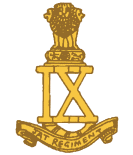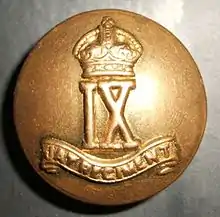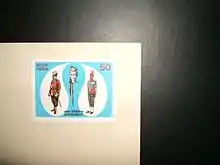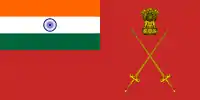Jat Regiment
The Jat Regiment is part of the infantry of the Indian Army, of which it is one of the longest-serving and most-decorated regiments.[2] The regiment has won 19 battle honours between 1839 and 1947,[3] and post-independence it has won five battle honours, eight Mahavir Chakra, eight Kirti Chakra, 32 Shaurya Chakras, 39 Vir Chakras and 170 Sena Medals.[2][4] During its 200-year service history, the regiment has participated in various actions and operations in India and abroad, including the First and the Second World Wars. Numerous battalions of the Jat Regiment, including the 14th Murray's Jat Lancers, fought in the First World War.[5]
| Jat Regiment | |
|---|---|
 Regimental Insignia of the Jat Regiment | |
| Active | 1795 – Present[1] |
| Country | |
| Branch | |
| Type | Line Infantry |
| Role | Infantry |
| Size | 24 Battalions |
| Regimental Centre | Bareilly, Uttar Pradesh |
| Motto(s) | Sangathan Va Veerta (Unity And Valour) |
| War Cry | Jat Balwan, Jai Bhagwan (The Jat is powerful, Victory to god!) |
| Anniversaries | July |
| Commanders | |
| Colonel of the Regiment | Lt Gen SK Saini, PVSM, AVSM, YSM, VSM, ADC |
| Insignia | |
| Regimental Insignia | The Roman numeral nine representing its ninth position in the regimental hierarchy of the Indian Army of the 1920s. The insignia also has a bugle indicating the Light Infantry antecedents of two of its battalions. |
History

British Indian Army: 1795 to 1947
The Regiment claims its origins from the Calcutta Native Militia that was raised in 1795,[6] which later became an infantry battalion of the Bengal Army. The 14th Murray's Jat Lancers was formed in 1857.[6] After 1860, there was a substantial increase in the recruitment of Jats into the British Indian Army. The Class Regiment, The Jats, was initially created in 1897 as infantry units from old battalions of the Bengal Army. In January 1922, at the time of the grouping of the Class Regiments of the Indian Army, the 9th Jat Regiment was formed by merging four active battalions and one training battalion into a single regiment.
The 1st Battalion was raised as the 22nd Bengal Native Infantry in 1803. The 2nd and 3rd Battalions were raised in 1817 and 1823 respectively. All three battalions had distinguished records of service, including the winning of many honours during World War I. The 1st Battalion served with great distinction in France and Iraq (then Mesopotamia) and was conferred the signal honour of being declared "Royal" in addition to being made Light Infantry.

The Regiment saw a great deal of fighting in North Africa, Ethiopia, Burma, Malaya, Singapore, and Java-Sumatra. A large number of gallantry awards including a Victoria Cross and two George Crosses were won. At the end of the war, the Regiment removed the numeral 9 from its title and became the Jat Regiment.
Gates of Somnath temple
After the Battle of Kabul (1842), Governor General Lord Ellenborough had ordered Major General William Nott, who was commanding British-Indian forces, to recover a set of ornate gates known as the Somnath Gates, which had been looted from India by the Afghans and hung at the tomb of Sultan Mahmud II.[7] A whole sepoy regiment, the 43rd Bengal Native Infantry—which later became the 6th Jat Light Infantry after the Indian Rebellion of 1857—was tasked with carrying the gates back to India.[8]
Post-independence
_by_AC_Lovett_(1862-1919).jpg.webp)
Following Indian independence from the UK in 1947, the Jat Regiment served in Indo-Pakistani War of 1947–1948, the 1962 Sino-Indian War, the conflicts with Pakistan in 1965 and 1971, and in Sri Lanka and Siachen. In 1965, 3 Jat under Lt Col (now Brig Retd) Desmond Hayde on 1 September and then again on 21–22 September, crossed the Ichhogil Canal and captured Dograi right up to Batapore-Attocke Awan, advancing towards Lahore. In the 1999 Kargil War, five of the regiment's battalions took part. The regiment has also contributed battalions to UN missions in Korea and Congo. It was also involved in counter-insurgency operations that have kept the Indian Army busy ever since independence.[9]
Battle cry
The battle cry, adopted in 1955, in Hindi, is जाट बलवान, जय भगवान (IAST: Jāt Balwān, Jai Bhagwān) (The Jat is Powerful, Victory Be to God!).
Regimental battalions

Currently the regiment has 23 regular battalions, 4 Rastriya Rifles battalions and 2 reserve battalions:
- 1st Battalion (now 2nd MECH)
- 2nd Battalion (former 15th Jat)
- 3rd Battalion (former 10th Jats) (Battle of Dogri)
- 4th Battalion
- 5th Battalion (Phillora Captors)
- 6th Battalion
- 7th Battalion (former 11th Jat)
- 8th Battalion
- 9th Battalion
- 11th Battalion
- 12th Battalion
- 14th Battalion
- 15th Battalion
- 16th Battalion
- 17th Battalion (Kargil)
- 18th Battalion
- 19th Battalion
- 20th Battalion
- 21st Battalion
- 22nd Battalion (Jaguars)
- 23rd Battalion
- 24th Battalian
- 5th Battalion of the Rastriya Rifles
- 34th Battalion of the Rastriya Rifles (Bravest of the Brave)
- 45th Battalion of the Rastriya Rifles
- 61st Battalion of the Rastriya Rifles
- 114 Infantry Battalion (TA) Jat
- 151 Infantry Battalion (TA) Jat
In 1979 the 1st Battalion was converted to the 2nd Battalion Mechanised Infantry Regiment.
Gallantry awards
Pre-1947
- Nagpur & Afghanistan, 1839
- Ghuznee (Ghazni, Ali Masjid & Kandahar), 1842
- Cabool (Kabul), 1842
- Maharajpore, Sobraon, Mooltan, Goojrat (Gujarat), Punjab & China, 1858–59
- Kandahar 1880
- Burma 1885–87
- Afghanistan 1879–80
- China 1900
- La Bassée 1914
- Festubert 1914–15
- Shaiba, Ctesiphon, Khan al Baghdadi & Kut al Amara, 1915
- Neuve-Chapelle, France & Flanders, 1914–15
- Kut al Amara 1916
- Mesopotamia 1914–18
- North-West Frontier Province 1914–15 & 1917
- Afghanistan 1919
- Razabil & Burma, 1942–45
- Jitra, Kanglatongbi & Malaya, 1941–42
- Ninshigum, the Muars & North Africa, 1940–43
Post-1947
- Zoji La & Rajauri, 1947
- Jammu and Kashmir 1947–48
- Phillora & Dograi 1965
- Jammu and Kashmir & East Pakistan 1971
Unit citations
When a unit is decorated for counter-insurgency operations, unit citations are given instead of battle or theatre honours.
- 4th battalion, Nagaland 1995
- 7th battalion, J&K 1997, J&K 2003 & Operation Rhino 2016
- 11th battalion, Operation Rakshak 2011
- 34th battalion Rashtriya Rifles, J&K 1997
- 17th battalion, Operation Vijay 1999
- 16th battalion, Operation Rakshak 2005 & 2011
- 21st battalion, Operation Rhino 2009
- 22nd Battalion (JAGUARS), Operation Rakshak 2018
Victoria Cross
- Risaldar Badlu Singh, 14th Murray's Jat Lancers attached to 29th Lancers (Deccan Horse), Palestine 1918.[11][12]
- Havildar Abdul Hafiz, 9th Jat Regiment, Imphal 1944.[11]
Maha Vir Chakra
- Brig. (later Lt. Gen.) Joginder Singh Bakshi, 16 Jat, 1971[13]
- Lt. Col. (later Brig.) Desmond Hayde, 3 Jat, Dograi 1965
- Maj. Asaram Tyagi, 3 Jat, 1965
- Capt. Anuj Nayyar, 17 Jat, Kargil 1999
- Capt. Kapil Singh Thapa, 3 Jat, 1965[14]
Vir Chakra
- Brig. Umesh Singh Bawa, 17 Jat, Kargil 1999
- Lt. Col Raj Kumar Suri, 4 Jat, 1971 war[15]
- Maj. Harish Chandra Sharma, 4 Jat 1971 war[16]
- Maj. Narain Singh, 4 Jat 1971 war[17]
- Maj. Deepak Rampal, 17 Jat, Kargil 1999
- Havildar Kumar Singh Sogarwal, 17 Jat, Kargil 1999
- Havildar Shish Ram Gill, 8 Jat, Kargil 1999
- Sep Dharajit Singh Chahar, 4 Jat, 1988
- Sub (later Capt.) Pahlad Singh, 2 Jat, 1971 war
- Sub Brijendra Singh, 4 Jat, 1971 war[19]
Ashok Chakra
- Maj Sudhir Kumar Walia, 4 Jat (parent unit), 9 Para (Special Forces)[20]
- Col Jojan Thomas, 45 Rashtriya Rifles[21]
- Maj Dinesh Raghu Raman, 34 Rashtriya Rifles, PU 19 Jat,[22]
Others

List of battles fought
See also
References
- Army's Jat Regiment Best Marching Contingent in Republic Day 2007 Parade | India Defence Archived 2007-02-02 at the Wayback Machine
- Army's Jat Regiment Best Marching Contingent in Republic Day 2007 Parade | India Defence http://www.dsalert.org/gallantry-awards/shaurya-chakra
- "Archived copy". Archived from the original on 2011-06-09. Retrieved 2011-01-09.CS1 maint: archived copy as title (link).
- Cornwell, Richard (2012-02-28). "2 Anti-Tank Regiment, Saa -Tank and Anti-Tank in the Western Desert, 1940-1942 (Part Iv)". Scientia Militaria – South African Journal of Military Studies. 6 (4). doi:10.5787/6-4-845. ISSN 2224-0020.
- The Times History of the War: The Battlefield of Europe. Woodward & Van Slyke
- "The valiant Jat soldier – The Tribute". Retrieved 26 November 2014.
- Dalrymple (2013), pp.444–445
- "britishbattles.com". Archived from the original on 12 October 2007. Retrieved 23 October 2007.
- http://www.globalsecurity.org/military/world/india
- "Official Website of Indian Army". Retrieved 26 November 2014.
- "We Were There – Medals and Awards – Victoria Cross Winners". Archived from the original on 2008-10-02. Retrieved 2008-03-13.
- Risaldar Badlu Singh, VC Archived July 11, 2007, at the Wayback Machine
- https://indianarmy.nic.in/Site/FormTemplete/frmTempSimple.aspx?MnId=C5TdyeWffP2/tmR3bzquSw==&ParentID=dSCH+6YL1sRl4Mp6nMRetg==&flag=8CKP966uzg96kLov0aWdfQ==
- https://www.honourpoint.in/profile/captain-kapil-singh-thapa-mvc
- http://gallantryawards.gov.in/Awardee/raj-kumar-suri
- http://gallantryawards.gov.in/Awardee/harish-chandra-sharma
- http://gallantryawards.gov.in/Awardee/narain-singh
- http://gallantryawards.gov.in/Awardee/dharajit-singh-chahar
- https://www.tribuneindia.com/news/punjab/1971-war-veteran-felicitated-190297
- https://www.honourpoint.in/profile/major-sudhir-kumar-walia
- http://gallantryawards.gov.in/Awardee/jojan-thomas
- http://gallantryawards.gov.in/Awardee/dinesh-raghu-raman
- Press Trust of India (19 February 2014). "Jat Regiment's battalion gets environment award". Retrieved 26 November 2014.
- http://timesofindia.indiatimes.com/india/National-helpline-for-soldiers-Army-widows/articleshow/29729885.cms
Further reading
- War Services of the 9th Jat Regiment by Lieutenant Colonel W. L. Hailes details the military history of the Jat Regiment and of the Jat people between 1893 and 1937.
